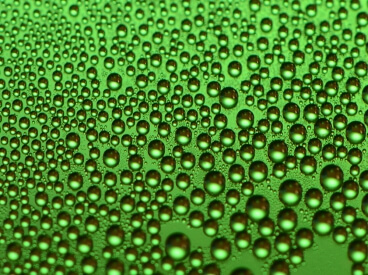Inspired by nature, scientists from MIT have created what they define as "the world's best water-repellent surface".

By: Ofir Marom
Water-repellent surfaces (super-hydrophobic) attract a lot of attention, due to their ability to stay dry and clean and their ability to prevent ice from accumulating on them, abilities that allow to improve the performance of many products. Generally, superhydrophobic surfaces are not smooth, as one might mistakenly think, but rather rough. These surfaces are covered with nanometric bumps, which minimize the contact area with the liquid. Therefore, the force of attraction between the liquid and the surface is also minimal, which causes the liquid to prefer to remain as a cohesive drop and not be spread over the surface ("lotus effect"). Professor Kripa Varanasi and his research group at MIT University have shown that a new strategy, different from what is accepted today, can improve the repellency of the surfaces significantly, in a way that until now was not considered possible.
The inspiration for the new water repellent coating came from observing advanced but very delicate surfaces that have developed in nature, such as the top of the monk's hat flower, or the wings of a Morpho butterfly. It turns out that the surface of these surfaces is covered in a pattern of tiny ridges. The research showed that this morphology was not created for nothing. The researchers proved that by coating a surface with tiny ridges, similar to the morphology of the monk's hat or the wings of a Morpho butterfly, it is possible to reduce the contact time beyond the theoretical limit, a parameter that until now was not thought to be possible to improve.
To date, in order to develop surfaces that repel water, researchers have focused on reducing the attractive forces between the liquid and the surface. But even when the force of attraction between the two is zero, still the hydrodynamic behavior of the drop dictated a minimal contact time, which resulted from the fact that the drop is crushed to the surface and then collected back into a drop symmetrically (like the left drop in the attached video). As a splash of water falls on a surface of tiny ridges, it splits into smaller droplets, each of which splashes separately. Since each of the small drops has a mass, which is less than the mass of the original drop, the time it takes to be pushed off the surface is also less (like the right drop in the attached video). Reducing the time that the liquid touches the surface increases the chance that the surface will remain dry, and more effectively prevents the accumulation of ice on it.
This development is particularly significant because the new textures can be combined with strong materials, such as metals or ceramics, which are resistant to abrasion and high heat, and not only on textiles or relatively fragile polymers, as is customary today to create water-repellent surfaces. It is easy to imagine the application of the idea in textiles, glass or tiles as is already done today. In addition, things, which until now have been less realistic, such as wind turbine blades, cars, jet engines or power lines can be expected to reduce the chance of ice formation. Now Prof. Veranci and his group are looking among the design community for ideas for possible applications. Maybe you have an idea?

6 תגובות
You can cover schnitzels with such surfaces and then if water drips on the schnitzel, which is not tasty at all, they will reject and it will be possible to continue eating the schnitzel. How did they not think of this before??
In the last lines of the article, they ask if we, the readers, have an idea to use the technology in question.
What do you have?
I have many ideas.
How much will they pay me for an idea?
I'm interested in the left drop.
"Like the left drop in the attached video."
Really thank you for taking the trouble to attach the video...
http://www.bbc.co.uk/news/science-environment-25004942